By Pete Vack
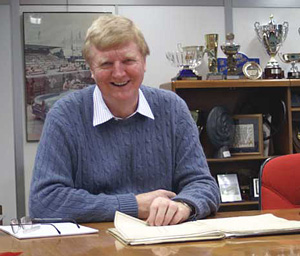 Simon Moore has recently completed his third…and perhaps last…volumes on the pre-war Alfa Romeos.
Simon Moore has recently completed his third…and perhaps last…volumes on the pre-war Alfa Romeos.
The Magnificent Monopostos, Alfa Romeo Grand Prix Cars, 1923 to 1951 is now available now from him directly at gpalfabook@gmail.com. ISBN number is 978-0-9820774-2-9 (for two volume set in slip case)
As most everyone knows, his venture into Alfa history began with the incredible book, The Immortal 2.9 which was followed by the The Legendary 2.3. Both were exceptional works, detailing the subject cars and tracing each one, serial number by serial number. Simon’s first book won the coveted Cugnot Award from the Society of Automotive Historians in 1986. The Legendary 2.3 covering the 8C2300 and Monza was awarded the Prix Bellecour in France in 2000. The 2.9 book has since been completely rewritten and a Revised Edition was published in 2008. Both books are still available from Parkside Publications.
Last of the breed
The Magnificent Monopostos promises to be not only the last of the series but the best, already winning the two most prestigious automotive book awards, the Royal Automobile Club “Book of the Year” and the International Historic Motoring Awards “Publication of the Year”. The two volume set is not inexpensive at £325, (about $500 USD) which includes shipping from the U.K (or £300 in Europe, £350 elsewhere)and yet the last of the run is moving quickly so one might not want to hesitate to ‘get em before they’re gone.’ The scope of this book required 836 pages split into two volumes; the first covers the cars beginning in 1923 and ending with the Tipo B and the Bimotore. The second volume concentrates on the cars of the later 1930s. And like the other two works, each car is given a separate chapter and traces the car from birth to the present day.
Why last of the series? Writes Moore, “I do not intend to do a book on Jano’s six cylinder cars I’m afraid. However, I have joined a group of historians who are working on a history of Maserati covering the years before the war plus the supercharged single-seaters after the war up to 1951. The book will follow a similar format to my new book The Magnificent Monopostos, for example including chapters on individual cars as well as a section on the racing speedboats powered by GP Maserati engines.”
The latest opus contains over 1140 photos, gathered over a long period of time from a variety of sources. “I tried to use as many photographs as possible that had never been published before or which had only appeared in obscure publications. Consequently, I only used a relatively small number of Alfa Romeo photographs provided by Marco Fazio at the Centro Storico in Arese, who has always been most helpful in my research. To write the completely revised edition of The Immortal 2.9 I had access to the Alfa Romeo racing records for 1936 to 1940 inclusive. For this new book, I managed to add the records for 1935 and 1946-51 inclusive with a wealth of ‘new’ information. Along the way, I also acquired more information about cars featured in both my previous books.”
We asked Simon what was the most difficult of the three books to write and research: “That is a tricky question! I think the answer is The Legendary 2.3 because of the much larger number of cars built by Alfa Romeo but that was all done in the 1990s so a long time ago. Having said that, the racing history in that book only really covered three seasons (1931/2/3) whereas the Monoposto book covers 1923 to 1951 inclusive.”
Monoposto plus
It was not meant to cover the earlier cars, but says Moore, “Initially I was going to start with the 1931 Tipo A (being the first Alfa single seater) but I found such great previously unpublished photos of 1923 to 1930 that I have included chapters on those seasons as well when Alfa raced the P1 and P2. The Monzas are covered in The Legendary 2.3 but I have also included the Alfetta, the Tipo 158/159 which started life as a Voiturette (or Formula 2) car but was a GP car post war until 1951. It has a different scope compared to David Venables’ book First Among Champions and the Tipo 158/159 which has been covered in a book of its own by Ed McDonough – so that car was mainly handled by using rarely seen photos.
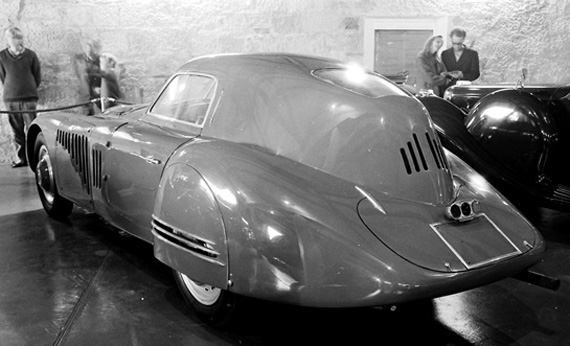
Graham Gauld took this photo of the Alfa Romeo 2900 Le Mans Coupe of 1938 as it looked in the 1970s at the Doune Motor Museum in Scotland. It was purchased by Mike Sparken and then traded to Alfa for a 158. Click photo to read Gauld’s Sparken story.
I was lucky enough to know Michel Poberejsky (who raced as Mike Sparken) and he kindly gave me the whole story of his acquisition of the Tipo 158 (the only one in private hands) in his own words. Sadly Michel passed away in 2012 and therefore could not see the book in its final form but he was of great help in writing the chapter on the Alfettas racing before the war. Sorting out previously unpublished photos and information on the cars designed by Ricart just before the war (which never raced) in conjunction with Patrick Italiano in Belgium was a lot of fun. Antonio Carlos Buarque de Lima in Rio de Janeiro helped enormously in sorting out the racing Alfas in Brazil which also included learning a lot more about the Monzas there which added to my knowledge compared to the 8C2300 book.”
What makes Simon Run…
For most of us, to have done one book comparable to The Immortal 2.9 would be a significant lifetime achievement; to have added The Legendary 2.3 and now The Magnificent Monopostos to the list is extraordinary to say the least. He has been driven; Moore is an archaeologist, an explorer blessed or cursed with the same kind of obsession that drove his British counterparts to search for the source of the Nile, the North and South poles, King Tut’s tomb and El Dorado. For most of his adult life he has travelled the world searching for information that will shed light on a particular subject. But it is his abilities as a detective that allow Moore to uncover the mysteries of the ancient Alfa Romeos; he possesses the skills of both Howard Carter and the legendary Sherlock Holmes. “I love the detective work involved in working out which car was which. Also there are lots of other Alfisti who spurred me on. Whenever I was feeling fed up with one aspect, someone would call or E mail with some exciting new photo find or whatever!”
Cars have always been a large part of his life. “I really cannot recall a time when I was not interested in cars. Three of my mother’s sisters married people in the motor trade; one worked at Bellevue Garage in London pre-war (where Wilkie Wilkinson was the head mechanic), one was in car transport and the other was involved in building the GSM Delta in the UK. My father used to keep me amused as a small child on long car journeys by seeing if I could identify the car coming the other way before he did.”
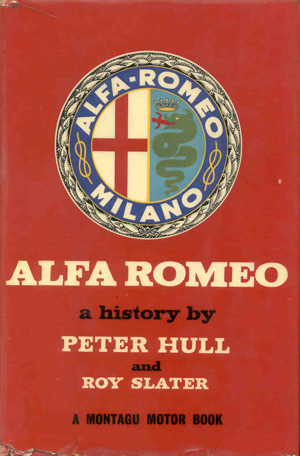 Despite living in the land of Bentleys and MGs, it was the Alfa Romeo that really caught his attention. “My mother bought me a copy of Kings of the Road by Ken Purdy, which introduced me to Alfas and other great marques, and the incredible exploits of Tazio Nuvolari. My copy of the book was later signed by Ken, date-lined 16th July 1968, in the Algonquin Bar in New York City, one of his favourite watering holes. Once interested in the history of racing, I became fascinated by Dick Seaman’s success in 1936 with a 10-year-old Delage, so arranged to see the car at Rob Walker’s garage in Dorking (near where I lived) in 1965. Whilst photographing the car, a passing motorist (Peter Giddings) stopped and asked if he could buy some of the photos (as recounted on pages 770/771 and 960 The Legendary 2.3) and he had an 8C2300 (2311243). That led to an interest in Alfas.”
Despite living in the land of Bentleys and MGs, it was the Alfa Romeo that really caught his attention. “My mother bought me a copy of Kings of the Road by Ken Purdy, which introduced me to Alfas and other great marques, and the incredible exploits of Tazio Nuvolari. My copy of the book was later signed by Ken, date-lined 16th July 1968, in the Algonquin Bar in New York City, one of his favourite watering holes. Once interested in the history of racing, I became fascinated by Dick Seaman’s success in 1936 with a 10-year-old Delage, so arranged to see the car at Rob Walker’s garage in Dorking (near where I lived) in 1965. Whilst photographing the car, a passing motorist (Peter Giddings) stopped and asked if he could buy some of the photos (as recounted on pages 770/771 and 960 The Legendary 2.3) and he had an 8C2300 (2311243). That led to an interest in Alfas.”
And this interest in turn led to an opportunity when in 1971 Moore met the well-known author of the landmark Alfa Romeo. “Hull asked me to add a ‘Where are they now’ feature as a side bar to his article ‘The Immortal 2.9‘ in Automobile Quarterly which appeared in 1973. When I moved to South Africa in 1984, I decided to put the individual histories from a hard covered exercise book onto my first computer. After some persuasion, I converted this into a manuscript for the book The Immortal 2.9. Mal Harris was the main voice to persuade me, but Fred Simeone helped!”
Owning pre-war Alfas and ugly Ferraris
Along the way, Moore has been not only a writer and Alfa historian but an owner of some of the significant pre-war Alfas and became as intimately familiar with the 2900 series.
“I had a 6C1750 twin cam unblown Alfa whilst in college. After starting work, I owned a Maserati A6G (single cam) chassis number 2020 with Pinin Farina bodywork and an engineless 212 Ferrari (chassis number 0165 EL) back in the late 1960s/early 1970s. The Ferrari was bodied by Abbott in the UK and looked like an over-grown Morris Minor convertible – probably the ugliest Ferrari ever! It went to pay the deposit on my first house.
“Then I discovered the rolling chassis of an 8C2900A Alfa and rebuilt that car in time to run the 1987 Mille Miglia. It went on to win awards at concours events in Europe (Villa d’Este, Bagatelle and Goodwood) and in the USA (at Pebble Beach). The cockpit was incredibly small and, after knee surgery (and on-going back problems), I found it increasingly difficult and painful to drive so parted with it after 25 years of fantastic fun. The last outing on the open road was from Carmel to Big Sur and back on California Route 1 in 2010 and then over the ramp at Pebble Beach to claim the most elegant convertible on the field. Having owned one of the fastest road cars made before the war means that anything else would be a disappointment so the only collector car I own is my MGA which I have owned for fifty years!”
Well, Simon, it was a job well done; a truly significant accomplishment. We look forward to reading the final volume ourselves, and we will no doubt review the forthcoming Maserati history as well.
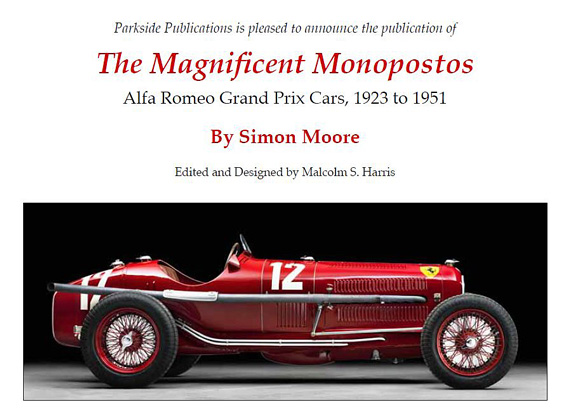
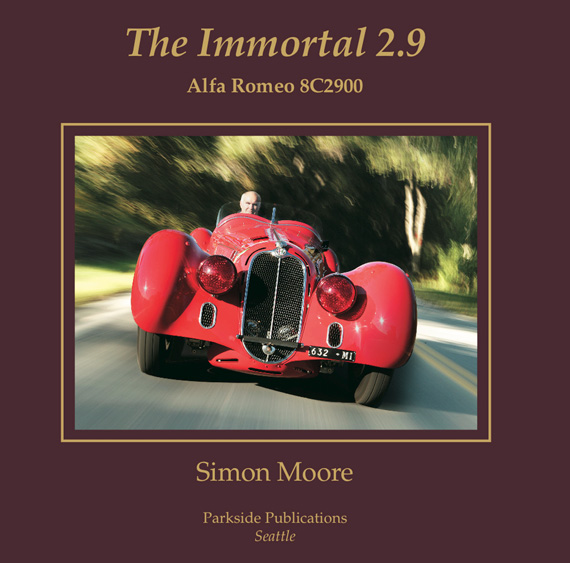
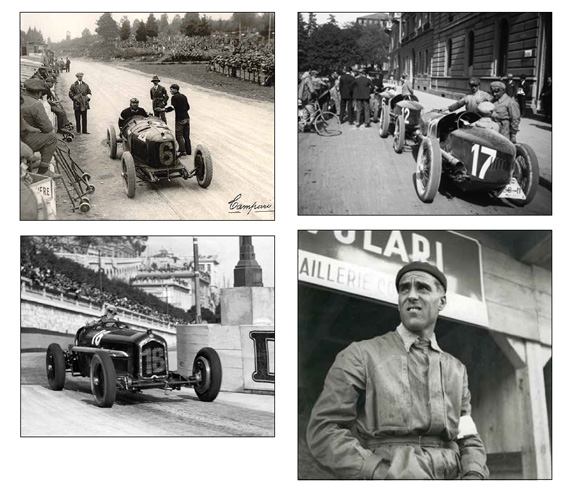
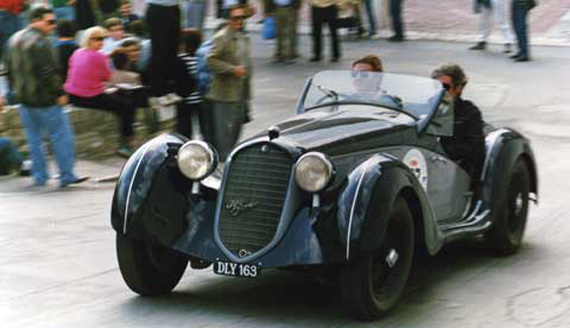
Having fallen in love with the 158 Alfetta Grand Prix cars as a kid in 1948 via pictures in The Motor and Autocar magazines, Mr Moores book was a must. albeit a very expensive one!. I treated myself last Christmas and have spent a most enjoyable and informitive year working through the great racing years of Alfa Romeo. These are 2 wonderful books. Many thanks Mr Moore.
I attended a Ferrari club meeting many years ago and listened to Simon recount the discovery of the 2.9 rolling chassis. One of the great automotive finds of all time.
Interesting to hear that the tiny Blue Bar at the Algonquin was one of Ken W. Purdy’s hangouts. It certainly fits the image I have of him. All of us owe Purdy a debt for the indelible images his words painted. Like Simon, many of us were inspired by the great Kings of the Road he wrote about.
I look forward to reading this latest book of Simon Moore, but it will be tough to top the Immortal 2.9! One question, does the book mention the very first Italian Monoposto? A hint, it was built in Brescia, not Milan.